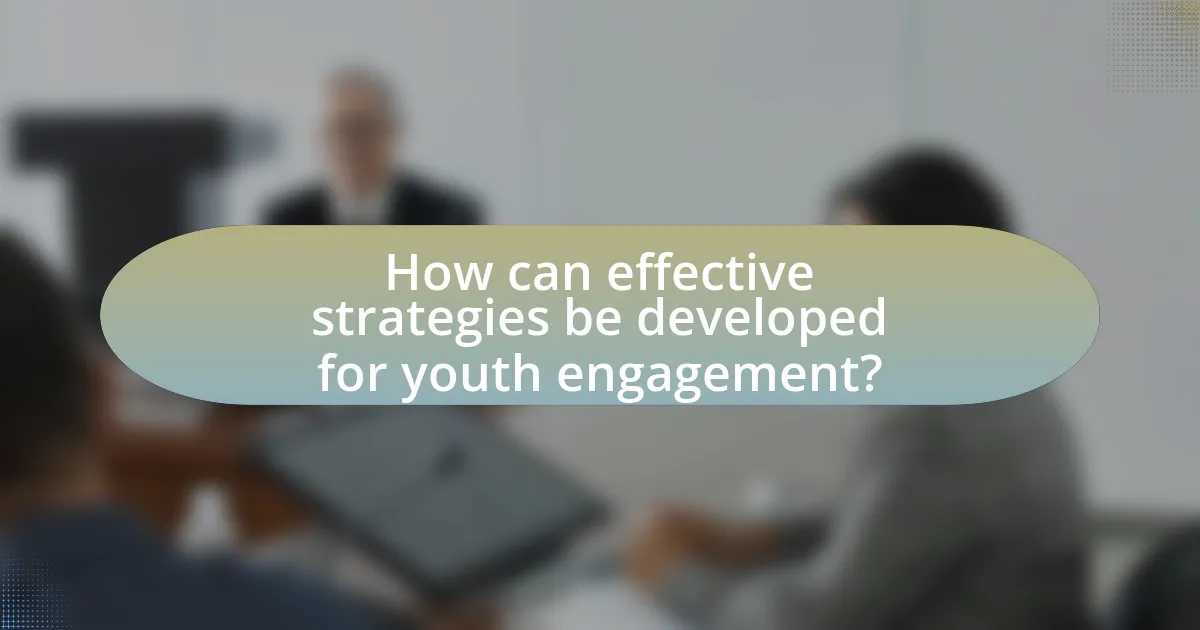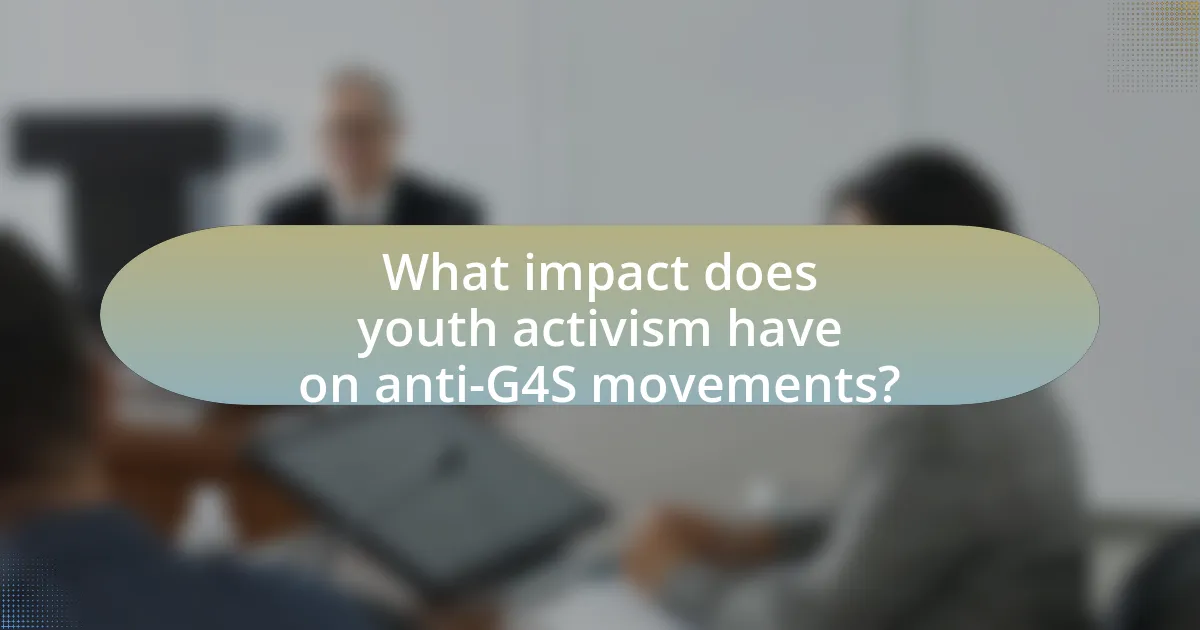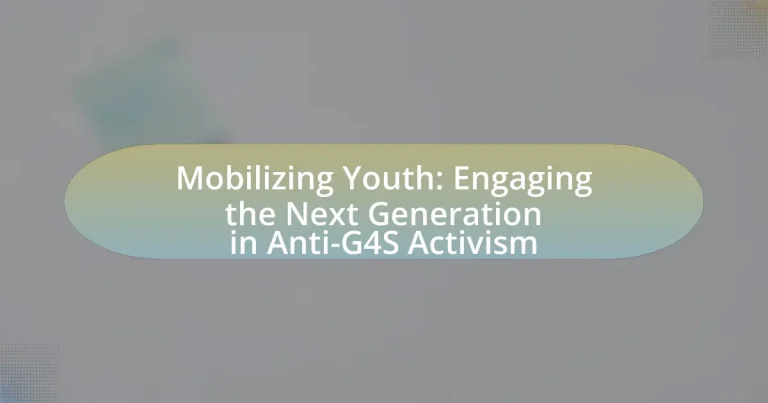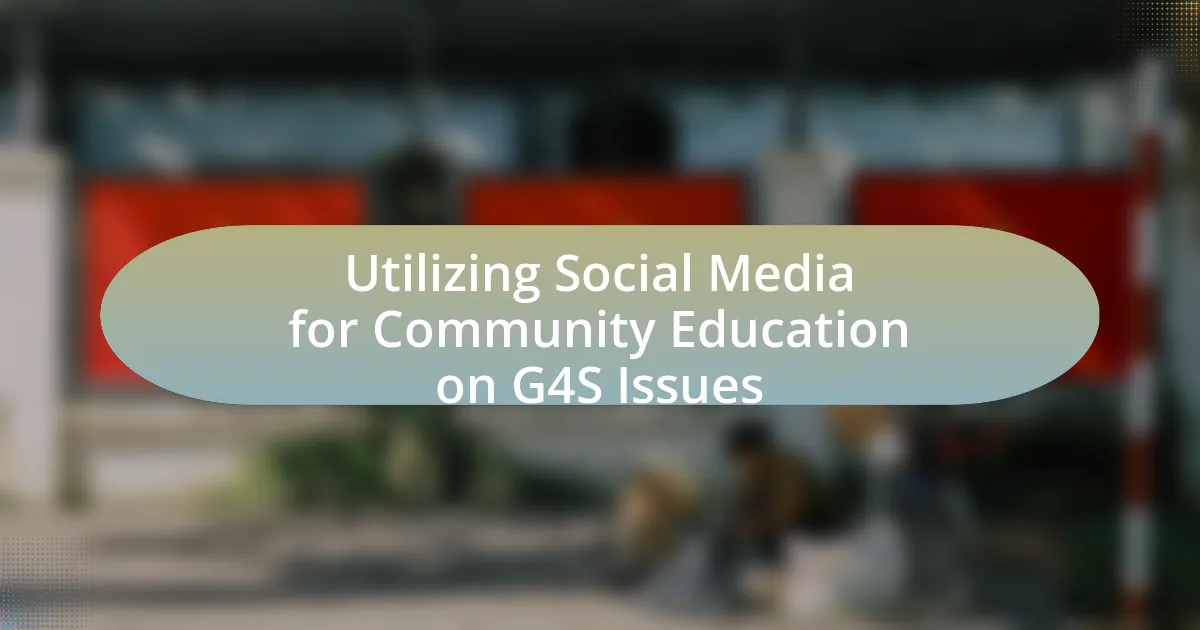Mobilizing youth in anti-G4S activism focuses on organizing and empowering young individuals to challenge the practices of G4S, a security company criticized for human rights violations. The article outlines the importance of youth engagement, historical contexts supporting their activism, and the unique characteristics that differentiate youth-led movements from traditional activism. It also addresses the challenges faced in mobilizing youth, such as apathy and resource limitations, while proposing strategies to overcome these barriers through education, collaboration, and inclusive practices. Additionally, the article highlights the impact of youth activism on public perception and policy changes regarding G4S, emphasizing the role of intersectionality and diverse voices in strengthening the movement.

What does mobilizing youth in anti-G4S activism entail?
Mobilizing youth in anti-G4S activism entails organizing and empowering young individuals to actively participate in campaigns against the practices of G4S, a security company often criticized for its involvement in human rights violations. This mobilization involves educating youth about the implications of G4S’s operations, fostering a sense of social responsibility, and providing platforms for collective action, such as protests, social media campaigns, and community outreach. Evidence of successful youth mobilization can be seen in various movements where young activists have effectively raised awareness and influenced public opinion, demonstrating the potential impact of youth engagement in social justice issues.
Why is youth engagement crucial in anti-G4S activism?
Youth engagement is crucial in anti-G4S activism because it harnesses the energy, creativity, and innovative thinking of younger generations to challenge systemic injustices. Young activists are often more adept at utilizing social media and digital platforms, which amplifies their voices and mobilizes broader support against G4S’s controversial practices, such as its involvement in privatized detention and security services. Research indicates that youth-led movements have historically driven significant social change, as seen in the global climate strikes initiated by young activists, demonstrating their potential to influence public opinion and policy. Engaging youth not only ensures the sustainability of the movement but also empowers them to take ownership of social justice issues, fostering a sense of responsibility and agency in shaping their communities.
What historical context supports youth involvement in activism?
Youth involvement in activism is historically supported by significant movements such as the Civil Rights Movement of the 1960s, where young people played crucial roles in protests and advocacy for racial equality. For instance, the Student Nonviolent Coordinating Committee (SNCC) was formed by college students who organized sit-ins and freedom rides, demonstrating the power of youth in driving social change. Additionally, the anti-Vietnam War protests in the late 1960s saw widespread participation from young Americans, highlighting their capacity to influence public opinion and policy. These historical examples illustrate that youth have consistently been at the forefront of activism, leveraging their energy and idealism to challenge injustices and advocate for reform.
How does youth activism differ from other forms of activism?
Youth activism differs from other forms of activism primarily in its focus on issues that directly affect younger generations, such as climate change, education reform, and social justice. This demographic often utilizes digital platforms for mobilization, allowing for rapid dissemination of information and engagement through social media, which contrasts with traditional activism that may rely on established organizations and slower communication methods. For instance, movements like Fridays for Future, initiated by Greta Thunberg, exemplify how youth-led initiatives can quickly gain global attention and participation, demonstrating a unique ability to influence public discourse and policy at a young age.
What are the key challenges faced in mobilizing youth?
The key challenges faced in mobilizing youth include apathy, lack of access to resources, and generational differences in communication. Apathy among youth often stems from disillusionment with political systems, leading to disengagement from activism. Additionally, limited access to resources such as funding, training, and mentorship can hinder their ability to organize effectively. Generational differences in communication styles, particularly the preference for digital platforms over traditional methods, can create barriers to engagement and collaboration. These challenges are supported by studies indicating that youth participation in activism is often influenced by their perceived efficacy and the availability of supportive networks.
What barriers prevent youth from participating in activism?
Barriers that prevent youth from participating in activism include lack of access to resources, limited awareness of issues, and social or familial pressures. Many young individuals face financial constraints that hinder their ability to engage in activism, such as transportation costs or the need to work. Additionally, a significant number of youth may not be fully informed about the issues at stake, which can stem from inadequate education or exposure to activism. Social dynamics, including peer pressure or disapproval from family, can also discourage youth from taking a stand. Research indicates that these factors collectively contribute to lower participation rates among young activists, highlighting the need for targeted strategies to overcome these obstacles.
How can these challenges be overcome?
To overcome the challenges in mobilizing youth for anti-G4S activism, organizations can implement targeted educational programs that raise awareness about the issues surrounding G4S. These programs should focus on the ethical implications of G4S’s operations, utilizing case studies and statistics that highlight the impact on communities. For instance, research by the International Federation for Human Rights indicates that G4S has been involved in human rights violations, which can be leveraged to inform and engage young activists. Additionally, creating platforms for youth to express their views and participate in activism, such as social media campaigns and community events, can foster a sense of ownership and urgency. Engaging youth through peer-led initiatives has proven effective, as seen in various grassroots movements where young leaders mobilize their peers around social justice issues.

How can effective strategies be developed for youth engagement?
Effective strategies for youth engagement can be developed by incorporating participatory approaches that empower young individuals to take active roles in decision-making processes. Research indicates that when youth are involved in shaping initiatives, they are more likely to feel a sense of ownership and commitment to the cause. For instance, the “Youth Engagement Toolkit” by the United Nations emphasizes the importance of creating platforms for youth voices, which has been shown to enhance their involvement in social movements. Additionally, utilizing digital tools and social media can facilitate communication and mobilization, as evidenced by the success of youth-led campaigns during the Arab Spring, where social media played a crucial role in organizing and spreading awareness.
What methods can be used to educate youth about G4S issues?
To educate youth about G4S issues, interactive workshops and educational campaigns can be effectively utilized. These methods engage young people through hands-on activities, discussions, and multimedia presentations that highlight the implications of G4S operations, such as human rights concerns and privatization of public services. Research indicates that participatory learning approaches, like role-playing and simulations, enhance understanding and retention of complex topics, making them particularly suitable for youth education. Additionally, leveraging social media platforms for awareness campaigns can reach a broader audience, encouraging youth to engage in discussions and activism related to G4S issues.
What role do social media and technology play in education?
Social media and technology play a crucial role in education by enhancing communication, facilitating access to information, and promoting collaborative learning. These platforms allow educators and students to share resources, engage in discussions, and participate in online learning communities. For instance, a study by the Pew Research Center found that 95% of teens have access to a smartphone, enabling them to utilize educational apps and online resources effectively. Additionally, technology fosters personalized learning experiences, allowing students to learn at their own pace and style, which has been shown to improve academic outcomes.
How can workshops and seminars enhance understanding?
Workshops and seminars enhance understanding by providing interactive learning experiences that facilitate knowledge retention and application. These formats encourage active participation, allowing attendees to engage with the material through discussions, hands-on activities, and real-world scenarios. Research indicates that experiential learning, as seen in workshops, can improve comprehension and retention rates by up to 75% compared to traditional lecture-based methods. Additionally, seminars often feature expert speakers who can clarify complex topics and answer questions, further deepening participants’ understanding.
What are the best practices for organizing youth-led initiatives?
The best practices for organizing youth-led initiatives include fostering inclusive participation, providing mentorship, and ensuring clear communication. Inclusive participation allows diverse voices to contribute, enhancing creativity and engagement. Mentorship from experienced individuals helps youth navigate challenges and develop leadership skills. Clear communication ensures that all members understand goals, roles, and expectations, which is crucial for effective collaboration. Research indicates that initiatives with strong mentorship and inclusive practices are more likely to succeed, as they empower youth and build a sense of community.
How can collaboration with existing organizations strengthen efforts?
Collaboration with existing organizations can strengthen efforts by leveraging their established networks, resources, and expertise. When youth activists partner with organizations that have a history of advocacy, they gain access to a broader audience and increased credibility, which can amplify their message. For instance, organizations like Amnesty International have extensive experience in human rights campaigns, providing valuable insights and strategies that can enhance the effectiveness of youth-led initiatives. Additionally, collaborative efforts can lead to shared resources, such as funding and training opportunities, which are crucial for sustaining activism. Research shows that coalitions often achieve greater impact, as evidenced by the success of the Global Climate Strike, where diverse organizations united to mobilize millions worldwide, demonstrating the power of collective action.
What types of events can effectively engage youth?
Interactive workshops, music festivals, and community service projects can effectively engage youth. These events provide hands-on experiences that foster participation and collaboration. For instance, interactive workshops allow youth to develop skills and express their opinions, while music festivals create a vibrant atmosphere that attracts young people and encourages social interaction. Community service projects not only address local issues but also instill a sense of responsibility and empowerment among participants. Research indicates that youth are more likely to engage in activism when they feel a personal connection to the cause, which these types of events facilitate.

What impact does youth activism have on anti-G4S movements?
Youth activism significantly amplifies anti-G4S movements by increasing visibility and mobilizing public support against the company’s controversial practices. Young activists leverage social media platforms to disseminate information rapidly, organize protests, and engage in advocacy, which has led to heightened awareness of G4S’s involvement in issues such as privatized policing and human rights violations. For instance, campaigns led by youth groups have resulted in substantial public pressure, influencing institutions to reconsider contracts with G4S, as seen in various universities that have divested from the company following student-led initiatives. This demonstrates that youth activism not only raises awareness but also drives tangible changes in policy and corporate accountability.
How does youth involvement influence public perception of G4S?
Youth involvement significantly influences public perception of G4S by shaping narratives and mobilizing community action against the company. When young activists engage in campaigns, they often utilize social media platforms to disseminate information, challenge G4S’s practices, and raise awareness about issues such as human rights violations and privatization of public services. For instance, campaigns led by youth organizations have highlighted G4S’s controversial role in immigration detention and security services, leading to increased scrutiny and public debate. This active participation not only amplifies critical voices but also fosters a sense of collective responsibility among peers, ultimately shifting public sentiment towards a more critical view of G4S.
What success stories highlight the effectiveness of youth activism?
Youth activism has led to significant successes, notably the global climate strikes initiated by Greta Thunberg, which mobilized millions of young people worldwide to demand action on climate change. This movement resulted in increased awareness and pressure on governments to commit to more ambitious climate policies, exemplified by the European Union’s Green Deal, which aims to make Europe the first climate-neutral continent by 2050. Additionally, the March for Our Lives campaign, driven by students from Marjory Stoneman Douglas High School after the 2018 shooting, successfully advocated for stricter gun control laws in several states, demonstrating the power of youth-led initiatives in influencing legislative change. These examples underscore the effectiveness of youth activism in driving social and political change.
How can youth activism lead to policy changes regarding G4S?
Youth activism can lead to policy changes regarding G4S by mobilizing public opinion and influencing decision-makers through organized campaigns and advocacy efforts. For instance, youth-led movements can raise awareness about G4S’s controversial practices, such as its involvement in immigration detention and security services, thereby pressuring policymakers to reconsider contracts and regulations associated with the company. Historical examples include the impact of youth activism on the divestment movement against apartheid in South Africa, which successfully led to significant policy changes. By leveraging social media and grassroots organizing, youth can effectively communicate their demands, garner support, and create a collective voice that compels legislative action against G4S’s operations.
What role does intersectionality play in youth activism against G4S?
Intersectionality plays a crucial role in youth activism against G4S by highlighting how various social identities, such as race, gender, and socioeconomic status, intersect to shape individuals’ experiences with systemic oppression. This framework allows young activists to understand and address the multifaceted nature of injustices perpetuated by G4S, a private security company often criticized for its involvement in human rights abuses. For instance, youth from marginalized communities may face unique challenges that are not adequately addressed by a one-size-fits-all approach to activism. By incorporating intersectionality, activists can create more inclusive strategies that resonate with diverse groups, thereby enhancing solidarity and collective action against G4S’s practices. This approach is supported by research indicating that intersectional activism can lead to more effective mobilization and advocacy efforts, as it acknowledges the complexity of individuals’ lived experiences.
How can diverse voices be included in the movement?
Diverse voices can be included in the movement by actively creating platforms for underrepresented groups to share their experiences and perspectives. This can be achieved through community forums, social media campaigns, and partnerships with organizations that focus on marginalized communities. Research indicates that inclusive movements benefit from a variety of viewpoints, which can enhance creativity and problem-solving (Harrison, 2020, Journal of Social Issues). By ensuring that diverse voices are not only heard but also integrated into decision-making processes, the movement can foster a more equitable and effective approach to activism.
What are the implications of ignoring intersectional issues?
Ignoring intersectional issues leads to the perpetuation of systemic inequalities and marginalization of vulnerable groups. When activists and organizations fail to consider how various social identities—such as race, gender, class, and sexuality—interact, they risk creating solutions that do not address the unique challenges faced by these groups. For instance, research by the American Psychological Association indicates that marginalized communities experience compounded disadvantages, which can result in lower participation in activism and advocacy efforts. This oversight can alienate potential allies and diminish the effectiveness of movements aimed at social justice, ultimately hindering progress toward equity and inclusion.
What practical steps can youth take to engage in anti-G4S activism?
Youth can engage in anti-G4S activism by organizing awareness campaigns that educate their peers about G4S’s involvement in controversial practices, such as privatized detention and security services linked to human rights violations. These campaigns can include distributing informational flyers, hosting workshops, and utilizing social media platforms to amplify their message.
Additionally, youth can participate in or organize protests and demonstrations to publicly express their opposition to G4S’s operations. Collaborating with existing activist groups can enhance their efforts, providing resources and a broader platform for their activism.
Engaging in letter-writing campaigns to local representatives and businesses that contract G4S services can also be effective, as it directly addresses decision-makers and encourages them to reconsider their associations with the company.
Finally, youth can educate themselves on the legal and ethical implications of G4S’s actions, allowing them to articulate informed arguments against the company and advocate for policy changes that promote human rights and accountability.
What resources are available for youth interested in activism?
Youth interested in activism can access various resources, including online platforms, community organizations, and educational programs. Websites like DoSomething.org and Youth Activism Project provide tools, guides, and opportunities for engagement in social issues. Additionally, local nonprofits often offer workshops and mentorship programs that focus on activism skills and community organizing. Research indicates that youth-led initiatives, such as the Sunrise Movement, have successfully mobilized young people around climate justice, demonstrating the effectiveness of these resources in fostering activism.
How can individuals create impactful campaigns on a local level?
Individuals can create impactful campaigns on a local level by identifying specific community issues and mobilizing local resources to address them. This involves conducting thorough research to understand the needs and concerns of the community, which can be supported by data from local surveys or studies indicating prevalent issues. Engaging local stakeholders, such as community leaders and organizations, enhances credibility and support for the campaign.
Utilizing social media platforms effectively allows individuals to reach a broader audience and foster community engagement, as evidenced by campaigns like the Ice Bucket Challenge, which raised awareness and funds for ALS through viral participation. Additionally, organizing local events, such as town hall meetings or workshops, facilitates direct interaction with community members, enabling a collaborative approach to problem-solving.
Incorporating storytelling techniques can also make campaigns more relatable and impactful, as narratives resonate with audiences on an emotional level, driving action and support. Overall, a combination of research, community engagement, effective communication, and collaboration with local entities leads to the creation of meaningful and impactful local campaigns.





